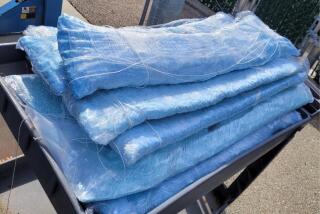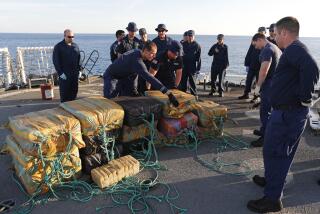Puerto Rico Cited as Main Caribbean Drug Pipeline
WASHINGTON â Lax enforcement has enabled Puerto Rico to become the main Caribbean pipeline for illegal drugs heading to the U.S. mainland, officials told a Senate panel Tuesday.
âCocaine and heroin traffickers from Colombia have transformed Puerto Rico into the largest staging area in the Caribbean for illicit drugs destined for the U.S. market,â said Michael Vigil, the Drug Enforcement Administrationâs agent in charge in the Caribbean.
About 512 metric tons of cocaine came into the United States last year, with one-fourth of that traveling somewhere through the commonwealthâs 300 miles of coastline and secluded cays, officials from the DEA, Customs Service and the Coast Guard told a Senate subcommittee.
âWe have not maintained control of our own backyard,â said Vice Admiral John Shkor, commander of the Coast Guard Atlantic Area.
The cocaine flow into Puerto Rico has increased threefold in the last two years, despite the increase in seizures by American officials, he said. And once itâs in Puerto Rico--a 110-mile long island with the third-busiest seaport in North America--smugglers have fewer problems getting it to the United States because things from the island are not searched by Customs, Shkor said.
âOnce itâs in Puerto Rico, from a customs standpoint, itâs effectively in Kansas,â said Shkor, who plans to focus on the drug trade in Puerto Rico this year.
The drug trade in Puerto Rico and other Caribbean countries such as Haiti will continue to rise with U.S. border officials cracking down on the smuggling through Mexico, Vigil said. In the 1980s, officials started cracking down on the Caribbean drug trade, so the drug runners moved their operations to Mexico. Now that officials have moved their forces to Americaâs southwest borders, the smugglers are moving back to the Caribbean, he said.
âWithout question, the illicit drug trade has a devastating effect not only on the United States, but also on those countries that are being used as transit points,â said Sen. Strom Thurmond (R-S.C.), chairman of the Senate Judiciary Committeeâs criminal justice oversight subcommittee. âPuerto Ricoâs murder rate, much of it drug-related, is reported to be the highest in the United States or its possessions.â
Officials estimate that 80% of the documented murders in Puerto Rico are drug-related, Vigil said.
Haiti also is becoming a big problem, said John Varrone, acting deputy assistant commissioner of the U.S. Customs Serviceâs office of investigations.
âThe political instability in Haiti, combined with its lack of law enforcement capabilities provides a safe haven to drug smuggling operations,â he said. âHaiti is clearly well positioned for traffickers to use as a path of least resistance, particularly when enforcement activity in Puerto Rico is high.â
Varrone showed the subcommittee video tapes of drug smugglers doing fly-by drops of drugs to waiting trucks and desperate boaters ramming customs boats in an unsuccessful attempt to escape capture.
Sen. Mike DeWine (R-Ohio) pointed out that Cincinnati had 464 heroin arrests in 1999, compared to 19 in 1990. He said he will push for increased funding for Customs, the Coast Guard and DEA to help stop of the flow of drugs through the Caribbean.
âThe ability of our law enforcement to succeed in keeping drugs off our streets is directly linked to our ability to keep drugs from ever reaching our shores,â he said.
More to Read
Sign up for Essential California
The most important California stories and recommendations in your inbox every morning.
You may occasionally receive promotional content from the Los Angeles Times.









